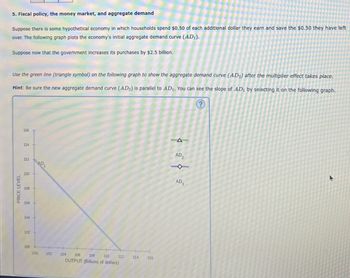
ENGR.ECONOMIC ANALYSIS
14th Edition
ISBN: 9780190931919
Author: NEWNAN
Publisher: Oxford University Press
expand_more
expand_more
format_list_bulleted
Question
whejw not use ai please

Transcribed Image Text:PRICE LEVEL
5. Fiscal policy, the money market, and aggregate demand
Suppose there is some hypothetical economy in which households spend $0.50 of each additional dollar they earn and save the $0.50 they have left
over. The following graph plots the economy's initial aggregate demand curve (AD1).
Suppose now that the government increases its purchases by $2.5 billion.
Use the green line (triangle symbol) on the following graph to show the aggregate demand curve (AD) after the multiplier effect takes place.
Hint: Be sure the new aggregate demand curve (AD2) is parallel to AD₁. You can see the slope of AD₁ by selecting it on the following graph.
(?)
116
114
112
AD
110
108
106
104
102
100
100
102
104
106
108
110
112
114
116
OUTPUT (Billions of dollars)
4 4
AD₂
4
AD3
Expert Solution
This question has been solved!
Explore an expertly crafted, step-by-step solution for a thorough understanding of key concepts.
Step by stepSolved in 2 steps with 2 images

Knowledge Booster
Similar questions
- Discuss externalities and government policies aimed at addressing them. Please Don't use chatgpt or other ai tool. If you know correct answer then attempt if you gave wrong answer then i gave 24 dislikes for you and more from my friends accounts also.arrow_forwardHow can SoleRebels the company use sustainability to create greater competitive advantage in the future?arrow_forwardHow expensive public transport is impact on people with low salary ? Graph it.arrow_forward
- Answer this questionarrow_forwardThere are 2 players. They take Ston eS From the Pilt of 6 Stones. Player 1 can takt only 2 or 3 Stones. piayer 2 can taKeS only 2 or 4 StonesS. P layers take turns, observe dil Previous moves, and player 1 mover first. A pla yer loses if She can not make a legal move, While another player ir declared the Winner. Let the pay oF OF Winning egval to 1 and the payoFF OF losing equal to 0. a) represent the in ɛxtemsive Form (depict Only legalmoes) b) Find all SPNE OF this game& explain your a mwwer. Who Will Win ? game Only legalmar)arrow_forwardSupply and Demand: End of Chapter Problems 9. Adjust each graph to show the indicated change. In each graph, click on the line or its midpoint to see the options. a. An increase in quantity demanded b. A decrease in demand Quantity Question Source: Chiang 4e- Economics Princidles FoHA Changing World Publisher: Worth 11:06 PI 65°F 10/13/20 Pricearrow_forward
- Find the strategies that survive IDSDSarrow_forwardBriefly discuss some of the problems of environmental command-and-control regulations. Edit View Insert Format Tools Tablearrow_forwardUser to calculate HHI do you convert the market share percentages into decimal numbers before squaring them.arrow_forward
arrow_back_ios
arrow_forward_ios
Recommended textbooks for you

 Principles of Economics (12th Edition)EconomicsISBN:9780134078779Author:Karl E. Case, Ray C. Fair, Sharon E. OsterPublisher:PEARSON
Principles of Economics (12th Edition)EconomicsISBN:9780134078779Author:Karl E. Case, Ray C. Fair, Sharon E. OsterPublisher:PEARSON Engineering Economy (17th Edition)EconomicsISBN:9780134870069Author:William G. Sullivan, Elin M. Wicks, C. Patrick KoellingPublisher:PEARSON
Engineering Economy (17th Edition)EconomicsISBN:9780134870069Author:William G. Sullivan, Elin M. Wicks, C. Patrick KoellingPublisher:PEARSON Principles of Economics (MindTap Course List)EconomicsISBN:9781305585126Author:N. Gregory MankiwPublisher:Cengage Learning
Principles of Economics (MindTap Course List)EconomicsISBN:9781305585126Author:N. Gregory MankiwPublisher:Cengage Learning Managerial Economics: A Problem Solving ApproachEconomicsISBN:9781337106665Author:Luke M. Froeb, Brian T. McCann, Michael R. Ward, Mike ShorPublisher:Cengage Learning
Managerial Economics: A Problem Solving ApproachEconomicsISBN:9781337106665Author:Luke M. Froeb, Brian T. McCann, Michael R. Ward, Mike ShorPublisher:Cengage Learning Managerial Economics & Business Strategy (Mcgraw-...EconomicsISBN:9781259290619Author:Michael Baye, Jeff PrincePublisher:McGraw-Hill Education
Managerial Economics & Business Strategy (Mcgraw-...EconomicsISBN:9781259290619Author:Michael Baye, Jeff PrincePublisher:McGraw-Hill Education


Principles of Economics (12th Edition)
Economics
ISBN:9780134078779
Author:Karl E. Case, Ray C. Fair, Sharon E. Oster
Publisher:PEARSON

Engineering Economy (17th Edition)
Economics
ISBN:9780134870069
Author:William G. Sullivan, Elin M. Wicks, C. Patrick Koelling
Publisher:PEARSON

Principles of Economics (MindTap Course List)
Economics
ISBN:9781305585126
Author:N. Gregory Mankiw
Publisher:Cengage Learning

Managerial Economics: A Problem Solving Approach
Economics
ISBN:9781337106665
Author:Luke M. Froeb, Brian T. McCann, Michael R. Ward, Mike Shor
Publisher:Cengage Learning

Managerial Economics & Business Strategy (Mcgraw-...
Economics
ISBN:9781259290619
Author:Michael Baye, Jeff Prince
Publisher:McGraw-Hill Education